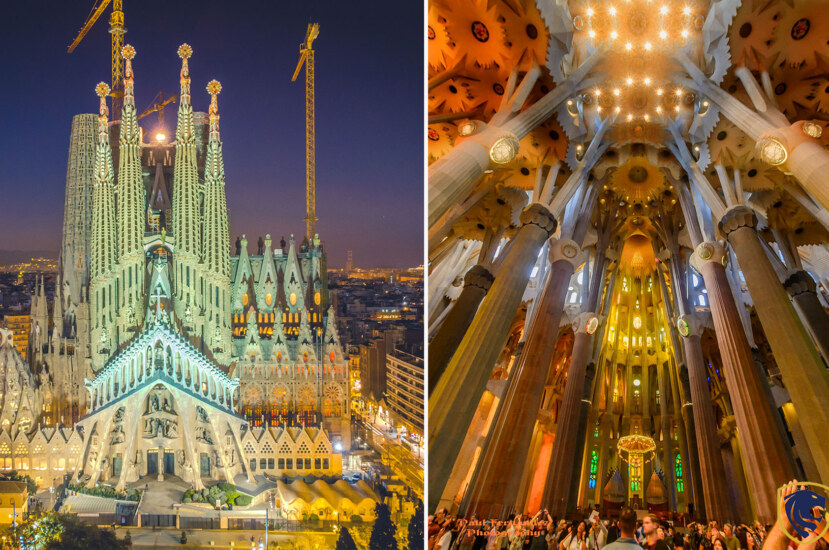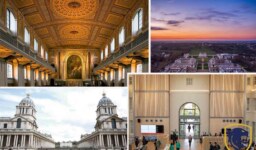Many Barcelona natives regard the Expiatory Temple of the Holy Family as the city’s most iconic landmark. Also, they consider this massive structure to be the one location you absolutely must see. If you have plans to visit the Catalan capital, you must read this article. The basilica was designed by Catalan architect Antoni Gaudi. Gaud attempted to incorporate complicated natural symbolism like organic, geometric shapes, which are conspicuous in every column, and pinnacle. Moreover, the stained glass window of the basilica is decorated with Christian rhetoric and biblical stories.
The outcome is a stunning architectural masterpiece. Yes I know, it is surprising that a building is incomplete and under construction for almost 141 years. But it is now considered one of Spain’s most popular tourist attractions, with 4.7 million visitors in 2019.
Design
The Sagrada Familia’s architectural style has been compared to Art Nouveau, Catalan Modernism, and Spanish Late Gothic. Although the Sagrada Familia was built during the Art Nouveau era, Nikolaus Pevsner remarks that Gaud, along with Charles Rennie Mackintosh in Glasgow, took the Art Nouveau aesthetic much more than just surface adornment.

Sagrada Família; Design
Plan
While it was never a cathedral, the Sagrada Familia was always intended to be a huge structure on the level of a cathedral in size. Its floor plan references previous Spanish churches like Burgos, León, and Seville Cathedral. The Sagrada Familia is compact compared to its length, like many other Gothic churches in Europe and Catalan architecture. Further, it is made up of many elegantly crafted components. It includes two aisles, an arcade with seven apsidal chapels arranged in a chevet, a profusion of steeples, and three doorways. They are all significantly different in terms of both structure and ornamentation. A covered path or monastery forms a rectangle around the church. Also, it flows through the hallway of each of its three entrances.

Sagrada Família; Plan
Towers
Currently, eight of the grand structure’s 18 towers have been completed. To honor the Disciples, twelve of them were to be built. In addition, four will be dedicated to the Evangelists, one to Mary, and one to Jesus, according to Gaud’s ideas. The height of each tower will vary according to the order of the represented religions.
Two of the church’s towers, one on either side of the temple, may be mounted for breathtaking views of the surrounding area. Also, it will offer a close-up look at the exterior design of the structure.

Towers
Façades
There are three facades on the basilica. They are Nativity Façade, The Passion Façade, and Glory Façade. Gaud left several drawings since he knew he wouldn’t be able to complete them, ensuring that his successors could complete the task properly.

Sagrada Família; Façades
Origins
Bookseller José Mara Bocabella served as the inspiration for the Sagrada Familia. After visiting the Vatican in 1872, Bocabella was thinking about constructing a church that was modeled after the basilica at Loreto. The church’s apse crypt was constructed in accordance with Francisco de Paula del Villar’s standard-form Gothic revival church design. Starting on March 19, St. Joseph’s Day, the construction was funded by donations. The design of the apse crypt was in Antoni Gaudi’s authority before the Villar retired on March 18th, 1883, and he significantly altered it. Although construction on the church began in 1883, Gaudi wasn’t the assigned Architect Director until 1884.

Sagrada Família Origins
Antoni Gaudi
While building the church, Gaudi developed a growing sense of religiosity. After 1910, he essentially stopped doing any other job. Also, finally, he isolated himself on the property and lived in the church’s workshop.
Together with his commitment to Religion, Gaud played a significant role in the Renaixensa, an aesthetic revival of the arts and crafts mixed with a political rebirth in the shape of ardent “Catalan” anti-Castilian sentiment. These revivals aimed to revive a way of life that had been long suppressed in Catalonia by the government of Spain, which was controlled by Castilian culture and centered in Madrid. The Sagrada Familia served as the spiritual center of the Renaixensa in Barcelona.

Antoni Gaudi
Most of Gaud’s attractive plans and models were destroyed during the Spanish Civil War. Those include a massive structure with room for 13,000 people. The Latin cross is encircled by porticoes on three sides and was constructed using a basic basilica design.
Why is this building not finished?
Even with modern technology, expert architects and engineers are having difficulty interpreting and realizing the intricate geometric designs that will make up the tallest cathedral in the world.
The Sagrada Familia was also a project that was supported by the people for the people. Therefore it has always depended on individual donations regardless of its worldwide fame. There have been instances in history when money was lacking, particularly during and after Spain’s Civil War. Construction didn’t begin to pick up speed dramatically until after the 1992 Olympic Games in Barcelona. When the city began to develop a worldwide profile and the number of tourists rose which made Spanish authorities speed up the construction of Sagrada Familia.

Why is this building not finished?
The Sagrada Familia was supposed to be finished in 2026. Because it will then be the time for the centennial of Gaud’s passing. But COVID-19 has delayed that date. Although work has already commenced, a new completion date has not been disclosed.
The things that Sagrada Família had to go through
Tourists and construction workers had to leave the sacristy after a minor fire sparked there by an arsonist on April 19, 2011. The sacristy sustained damage, and it took 45 minutes to put out the fire.

The things that Sagrada Família had to go through
Since the Spanish Civil War, the building hadn’t been stopped before. Also closed was the Gaud House Museum in Park Güell. On July 4th, 2020, the basilica reopened, first to critical individuals.
How to visit the Sagrada Família?
Santuario de la Family The Barcelona City Pass comes with Complimentary tickets for Skip the Line Entrance. Booking the Barcelona City Pass is preferable to merely purchasing tickets for the Sagrada Familia. That will offer you the chance to see the Park Gull and the city.

How to visit the Sagrada Família?
There is no need for you to print the tickets. Because they will be supplied immediately to your smartphone. With the use of the tickets, you will be able to visit the Sagrada Familia and the Park Gull without having to wait in line. Also, by just presenting your e-ticket before boarding, you will be allowed to ride the Barcelona hop-on hop-off bus as many times as you like during 24 hours to explore the city.




